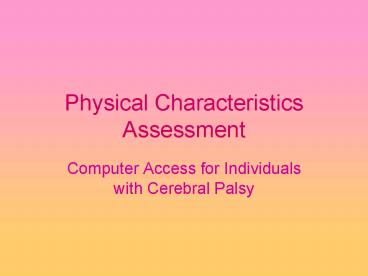Physical Characteristics Assessment - PowerPoint PPT Presentation
1 / 16
Title:
Physical Characteristics Assessment
Description:
Evaluation of foot movements in relation to switch and joystick placement for ... Mouth pointer. Cushion. Foot stool. PCA Results ... – PowerPoint PPT presentation
Number of Views:27
Avg rating:3.0/5.0
Title: Physical Characteristics Assessment
1
Physical Characteristics Assessment
- Computer Access for Individuals with Cerebral
Palsy
2
What is Cerebral Palsy?
- What It Is. Cerebral palsy, or CP, is a
heart-breaking condition for the parents of
children who are over-powered by an inability to
control body movements. CP is known as a static
encephalopathy, meaning that once the condition
has resulted in permanent brain injury, the
number of brain cells lost does not change over
time. Approximately 500,000 people in the United
States have cerebral palsy. CP symptoms include
unusually weak muscles or tight, spastic muscles.
There may be difficulty with balance, poor
coordination, abnormal reflexes, and delay in
developing motor skills such as sitting, walking
and talking. - The name cerebral palsy refers exclusively to
problems with movement, but the underlying brain
injury often causes other neurological problems.
Many children with CP will also develop seizures,
and some most unfortunate individuals will have
severe mental redardation as well. Cases of
cerebral palsy can range from severe to mild and
almost unnoticeable.
3
Why was PCA Developed?
- Prior to the PCA, there wasnt any other AT
assessment developed specifically for individuals
with physical limitations of cerebral palsy.
4
PCAs Purpose is to determine
- Body parts and movements that will enable
computer activation - The type of device that can facilitate computer
activation - Basic postural considerations related to computer
access by individuals with cerebral palsy
5
The PCA was developed with the following
presumptions
- An individual will activate a computer most
effectively from a seated position, often from a
wheelchair - Persons undergoing evaluation are comfortably
positioned in a therapeutically prescribed
seating system - Positioning devices depicted in this assessment
are nonprescriptive common household items that
may be used on a temporary basic to improve
posture
6
PCA Presumptions--Continued
- It is not possible to depict every example of a
particular posture in this assessment - It is not possible to depict every available
device designed to improve sitting posture - It is not possible to depict every computer input
7
PCAs Design
- Body Parts for Activation
- This part is the most important, because it
determines which parts to focus on or to omit
from the PCA. - Finger Activation
- Use of devices to facilitate finger-activated
direct selection via a standard, adapted or
alternative computer keyboard - Activation via Head Pointers, Mouth Held Devices,
or Voice - Use of pointers to permit head-activated direct
selection via a standard, adapted, or alternative
computer keyboard or via voice activation
8
PCA Design--Continued
- Activation via Hand/Arm Movement
- Evaluation of hand and arm movements in relation
to switch placement for indirect (i.e. scanning)
selection of input data - Activation via Head Movement
- Evaluation of head movements in relation to
switch placement for indirect (i.e. scanning)
selection of input data - Activation via Knee Movement
- Evaluation of knee movement in relation to switch
placement (i.e. scanning) selection of input data
9
PCA Design--Continued
- Activation via Foot Movement
- Evaluation of foot movements in relation to
switch and joystick placement for indirect (i.e.
scanning) selection of input data - Basic Postural Considerations
- Identification of basic postural considerations
designed to reduce fatigue and stress and
facilitate computer use
10
Equipment Needed for Evaluation
- Computer monitor
- Computer keyboard
- Mouse
- Trackball
- Key guard
- Light pointer (optical indicator)
- Switch Assortment
- Joystick
- Voice Recognition
- Enlarged Keyboard
- Mini Keyboard
11
Positioning Equipment for PCA
- Utility holder
- Mitten
- Finger guard
- Wrist support
- Wrist rest
- Forearm support
- Head pointer
- Chin pointer
- Mouth pointer
- Cushion
- Foot stool
12
PCA Results
- The Table where results are recorded looks like
this (a picture will be inserted)
13
PCA Results Summary
- The Summary Chart looks like this
14
PCAs Critique
- To the question Did your method of computer
activation change as a result of this
assessment? - 50 of respondents agreed
- PCA is a great assessment tool, so long as it is
used in a greater framework, i.e. embedded in the
SETT or Unifying Functional Model, where, except
for the strict needs assessment, the specific
environment in which an individual functions is
also considered.
15
References
- Fraser, Beverly, A., et al, Physical
Characteristics Assessment Computer Access for
Individuals with Cerebral Palsy. Don Johnston,
Inc. - (on cerebral palsy)
16
Web Resources for Further Reading
- On Cerebral Palsy
- http//www.cp-information.com/main.htm
- http//www.about-cerebral-palsy.org/definition/spa
stic-athetoid-ataxic.html - On PCA
- http//trecenter.org/appendixA.htm
- http//fritschi.home.mindspring.com/offlipub.html































